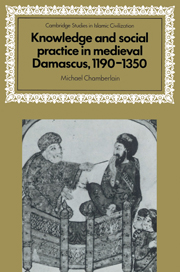Book contents
- Frontmatter
- Contents
- Preface
- List of abbreviations
- 1 Damascus and its surrounding region
- 2 Damascus in the thirteenth century
- Introduction
- 1 The acyān of Damascus, 590/1193–750/1350
- 2 Madrasas, the production of knowledge, and the reproduction of elites
- 3 Manṣabs and the logic of fitna
- 4 Social and cultural capital
- 5 Truth, error, and the struggle for social power
- Summary
- Bibliography
- Index
2 - Madrasas, the production of knowledge, and the reproduction of elites
Published online by Cambridge University Press: 06 November 2009
- Frontmatter
- Contents
- Preface
- List of abbreviations
- 1 Damascus and its surrounding region
- 2 Damascus in the thirteenth century
- Introduction
- 1 The acyān of Damascus, 590/1193–750/1350
- 2 Madrasas, the production of knowledge, and the reproduction of elites
- 3 Manṣabs and the logic of fitna
- 4 Social and cultural capital
- 5 Truth, error, and the struggle for social power
- Summary
- Bibliography
- Index
Summary
The study of madrasas would seem an ideal way of analyzing an institution that articulated relations among politics, cultural practices, and the strategies of social elites. Scholars have generally believed that the appearance of madrasas in the high medieval Middle East transformed higher education. They have also often agreed that madrasas had structures and uses similar to the specialized institutions of higher education in other societies, especially in educating jurists and bureaucrats by providing them an advanced legal curriculum. This chapter examines the madrasas of high medieval Damascus to address two major questions. What was the relationship between the transmission of knowledge and the proliferation of household waqfs such as madrasas in the city? How did madrasas serve elite social and political strategies?
As noted above, an earlier generation of scholars saw madrasas as institutions intended to develop the ideological cadres necessary for the “Sunnī Revival.” George Makdisi, who performed such a signal service in demolishing these views, is himself a strong proponent of viewing madrasas as a form of “institutionalized education.” Having argued successfully against earlier interpretations, Makdisi continues to see madrasas as having an organized and differentiated student body, a specialized curriculum, a professoriate certified to teach, and an institutional educational goal – the certification of teachers and jurists. Where Makdisi recognizes that much learning was private, he still sees the madrasa as the major institution of higher education. In this view, students followed “the basic undergraduate law course,” which led to “the license to teach.” Makdisi has been criticized for his use of anachronistic language, but at least it has the virtue of rendering the texts into familiar terms of reference.
- Type
- Chapter
- Information
- Publisher: Cambridge University PressPrint publication year: 1995



